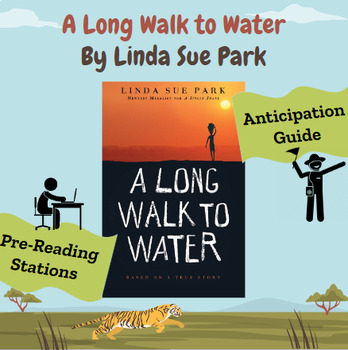A Long Walk to Water - Pre-Reading Stations & Anticipation Guide
School of Fishman
2 Followers
Grade Levels
5th - 8th
Subjects
Resource Type
Standards
CCSSRI.6.1
CCSSRI.6.5
CCSSRI.6.7
CCSSCCRA.R.2
CCSSCCRA.R.5
Formats Included
- Google Slides™
Pages
15 pages
School of Fishman
2 Followers

Made for Google Drive™
This resource can be used by students on Google Drive or Google Classroom. To access this resource, you’ll need to allow TPT to add it to your Google Drive. See our FAQ and Privacy Policy for more information.
What educators are saying
My students were fully engaged throughout this entire lesson. I spread it out over multiple class periods which worked perfectly. It was easy for the students to navigate as a whole group or individually. It aligned well with the story as well.
Description
A Long Walk to Water by Linda Sue Park has a rich historical context that is critical to understand before reading. The various pre-reading activities in this product allow students to engage with the novel before even opening it. Included activities are a photo gallery walk, a Water Footprint assessment, a book cover "tasting", a look at text features, journal questions, historical context, and more!
Total Pages
15 pages
Answer Key
N/A
Teaching Duration
4 days
Report this resource to TPT
Reported resources will be reviewed by our team. Report this resource to let us know if this resource violates TPT’s content guidelines.
Standards
to see state-specific standards (only available in the US).
CCSSRI.6.1
Cite textual evidence to support analysis of what the text says explicitly as well as inferences drawn from the text.
CCSSRI.6.5
Analyze how a particular sentence, paragraph, chapter, or section fits into the overall structure of a text and contributes to the development of the ideas.
CCSSRI.6.7
Integrate information presented in different media or formats (e.g., visually, quantitatively) as well as in words to develop a coherent understanding of a topic or issue.
CCSSCCRA.R.2
Determine central ideas or themes of a text and analyze their development; summarize the key supporting details and ideas.
CCSSCCRA.R.5
Analyze the structure of texts, including how specific sentences, paragraphs, and larger portions of the text (e.g., a section, chapter, scene, or stanza) relate to each other and the whole.


